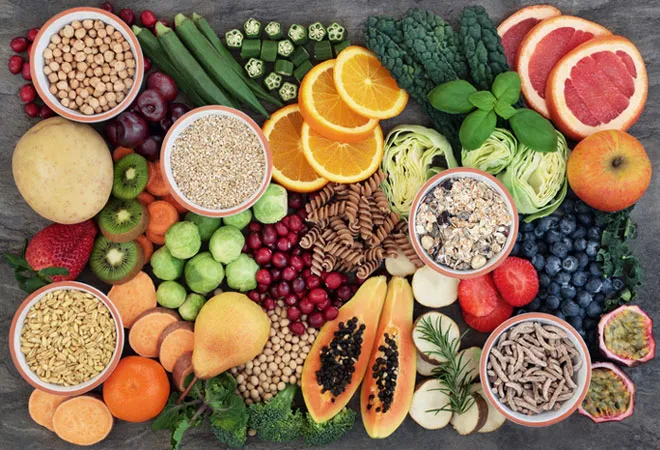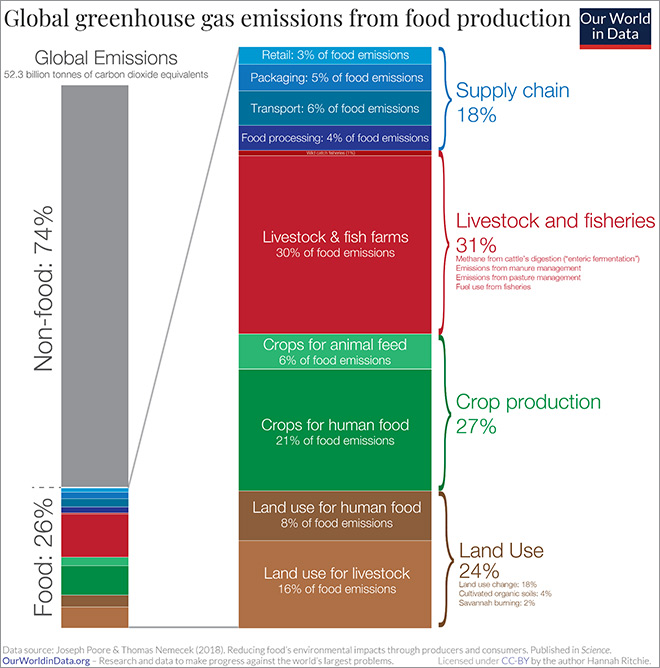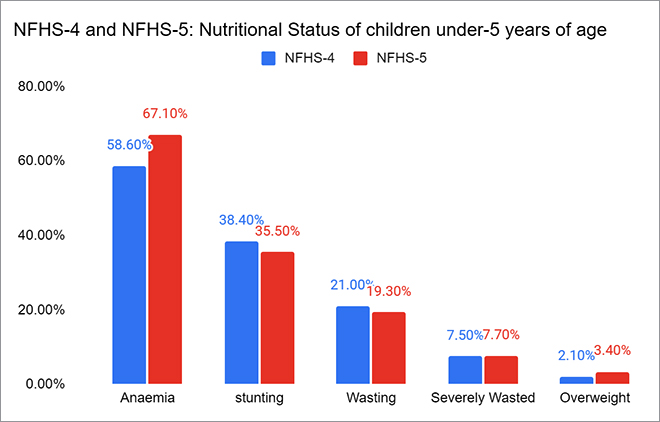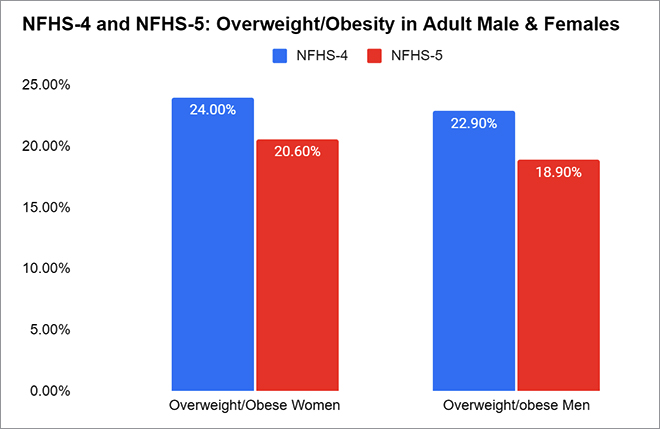
The COVID 19 pandemic threw fresh challenges at overcoming the global nutrition crisis and highlighted the importance of sustainable eating to combat malnutrition, hidden hunger and diet related non-communicable diseases. The number of deaths attributed to poor diet has risen by 15% since 2010 and is now responsible for more than 12 million NCD deaths in adults. This amounts to a quarter (26%) of all adult deaths annually. At the same time, global food demand is now responsible for 30% of all greenhouse gas emissions (GHGe), with animal foods responsible for the majority of GHGe (fig 1). As compared to 2010, the environmental impacts of food demand grew by as much as 14%.
Figure 1: Global greenhouse gas emissions from food production
 Source: Our World in Data
Source: Our World in Data
The financial need to address new nutrition challenges due to the impact of COVID 19 has increased by many folds. To meet nutrition targets on stunting, wasting, maternal anemia and breastfeeding by 2030 alone there is a need for additional 10.8 billion USD between 2022 and 2030.
According to the National Family Health Survey (NFHS) 2019-21, the 5th in the series India has seen no significant improvement in health and nutritional status among her population. The latest data shows, 7.7% of children are severely wasted, 19.3% are wasted and 35.5% are stunted. At the same time, 3.4% children are overweight which was 2.1% in NFHS-4 (fig 2). Anemia among children under-5 has become significantly worse with the current prevalence as 67.1% compared to 58.6% according to NFHS-4. 57% of women of reproductive age are anemic in the country.
Figure 2: Nutritional status of children under-5 years of age

Overweight or obesity is also on the rise among Indian adult male and females. NFHS-5 recorded 24% adult women to be overweight or obese compared to 20.6% in NFHS-4. 22.9% adult men are overweight or obese according to NFHS-5 which was 18.9% as reported by NFHS-4 (fig 3).
Figure 3: Overweight and Obesity Status among Adult Male & Females

Ensuring an easily accessible, balanced diet to eliminate malnutrition has become more challenging for vulnerable communities, such as people living in poverty, women and children, and senior citizens. Additionally, prolonged lockdown, restricted movement, lack of Vitamin D, limited access to fresh foods have increased the incidence of metabolic disorders including overweight, obesity, diabetes type 2, and cardiac diseases. This dual burden of malnutrition seeks immediate attention to improve nutrition for good health worldwide. A comprehensive need-based approach is the need of the hour to tackle poor nutrition and address inequality by policy reform, effective implementation of nutrition programs and ensuring a seamless food distribution system. To recover lost health during the pandemic, as well as to ensure the population remains resilient in the future, sustainable nutrition is crucial.
Global Nutrition Report 2021 and India - In 2012, World Health Organization identified 6 global nutrition targets to be achieved by 2025 that included – 50% reduction of anemia among women at reproductive age, 30% reduction in low birthweight, increase the rate of first 6 months' exclusive breastfeeding up to at least 50%, 40% reduction of stunting among under-5 children, ensuring below 5% reduction and maintenance of under-5 wasting, no increase in under-5 overweight; and seizing the increase in obesity and diabetes prevalence. The 2021 Global Nutrition Report (GNR 2021) revealed five out of six global maternal, infant and young children nutrition (MIYCN) targets to address stunting, wasting, anemia, low birth weight and childhood obesity are off track. At the same time, the global nutrition target (GNT) to combat the growing prevalence of non-communicable diseases (NCDs) is also off track. A shift from eating whole-food-based balanced meals to consuming sugary drinks, ultra-processed foods and processed red meat is negatively impacting our health and environment.
Figure 4: India’s progress towards the global nutrition targets
 Source: Global Nutrition Report 2021 India Profile
Source: Global Nutrition Report 2021 India Profile
Except for three MIYCN targets, India is off track to achieve all other GNTs (fig 4). India is 'on course' in meeting the target for stunting but, 34.7% of children under 5 years of age are still impacted, much higher than the Asian average of 21.8%. There is no progress achieved towards achieving the GNT for wasting. In comparison to the Asian average (9.1%), India has 17.3% stunted children under 5 years of age. Meanwhile, India reported some progress in ensuring exclusive breastfeeding with 58.0% of infants aged 0 to 5 months being exclusively breastfed. Unfortunately, there is not enough data to assess India’s progress towards achieving the low birth weight target or prevalence.
Indian diet is significantly low in fruits, legumes, nuts, fish, and dairy that are crucial for optimum growth, development and prevention of NCDs.
India has shown limited progress towards achieving GNT for diet related NCDs. According to GNR 2021, an estimated 6.2% adult (aged 18 and above) women and 3.2% adult men in India are living with obesity. Meanwhile, diabetes is estimated to affect 9% of adult women and 10.2% of adult men.
India is eating a poor diet – GNR 2021 reported a comparison of the dietary intakes of key foods and nutrients among adults aged 25 years and over with the minimum and maximum targets. The data revealed that except for whole grains, adult Indians are not meeting recommended dietary target for essential food groups, determined by the EAT-Lancet commission on healthy diets from sustainable food systems. Indian diet is significantly low in fruits, legumes, nuts, fish, and dairy that are crucial for optimum growth, development and prevention of NCDs.
Figure 5: Dietary intakes of key foods and nutrients in adults aged 20 years and over compared against minimum and maximum targets
 Source: Global Nutrition Report 2021 India Profile
Source: Global Nutrition Report 2021 India Profile
Where are we lacking? In recent years, India has become self-sufficient in grain production and has enjoyed steady economic growth. Despite this success, there is no alleviation of poverty, food insecurity and malnutrition in the country. In a report, WFP revealed, almost 21.25% Indian population lives on USD 1.90/day with a huge spectrum of inequality and social exclusion. In terms of public health nutrition, the following reasons might be the biggest obstacle to ensuring food for all in the country.
Growing prevalence of food insecurity – In 2019, India had 6.2 crore more people living with food insecurity, which increased by 3.8% between 2014 and 2019. In 2020, India is home to nearly 200 million undernourished people. The COVID 19 pandemic and subsequent lockdown has made food insecurity worse by disrupting the food distribution system across large parts of India. In a study, Anupriya Saxena & colleagues documented two-thirds of 211 respondents from a migrant tribal community in Rajasthan mentioning no sufficient food in their household. 97% of them didn’t have enough money to buy food. In their study, Garima Rautela & colleagues surveyed 4334 households from Delhi and Chennai and reported the overall prevalence of food insecurity was 8.5% of the poorest households compared to 1.7% of the wealthiest households.
Experts criticized ambitious Poshan Abhiyaan 2018 that could only reduce stunting among children aged 0 to 3 years of age only by one percentage point unlike its promise to reduce stunting by three percentage points per year.
In 2019, NITI Aayog’s ‘Strategy for New India @ 75’ report found that India's main nutrition program platform, Integrated Child Development Services (ICDS) has inadequate focus on the first 1000 days of the child’s life. This report argued that the program mainly delivers services to children aged 3 to 6 years old, whereas children under 2 to 3 years of age should be given the highest priority to ensure optimum growth and development among young children. Experts criticized ambitious Poshan Abhiyaan 2018 that could only reduce stunting among children aged 0 to 3 years of age only by one percentage point unlike its promise to reduce stunting by three percentage points per year.
India’s public distribution system (PDS) aims to distribute essential commodities to the marginalized population at subsidized rates to ensure food security for all. However, there are persistent problems in India's PDS such as fake supply of ration cards leaving the poor left out, selling the commodities on the open market, not supplying permitted amounts of food grains by the fair price shops, replacing good quality food grains with cheap varieties, etc.
Policy initiatives are urgently needed to transform the existing food system by involving all stakeholders.
Gaps and road to recovery – The global nutrition targets lack environmental impact of food and how to address micronutrient deficiency. Additionally, nutritional assessments for childhood and adolescent malnutrition are not explicit. The first step for India to combat the dual burden of malnutrition, nutrition inequality, and food insecurity is to fill the gaps in the nutrition composition of the daily diet. Ensuring sustainable eating by adding nutrient-dense, climate-smart crops such as millets to the Indian daily diet could be rewarding in preventing nutritional deficiency and diet related NCDs. Policy initiatives are urgently needed to transform the existing food system by involving all stakeholders. More finance is needed to meet additional requirements to address pandemic-induced nutritional loss. At the same time India needs a better data management system, greater accountability in the food distribution system, efficient resource management, adequate nutrition education, reinforcement of manpower and systematic monitoring to aim at achieving global nutrition targets by 2030.
The views expressed above belong to the author(s). ORF research and analyses now available on Telegram! Click here to access our curated content — blogs, longforms and interviews.









 PREV
PREV



